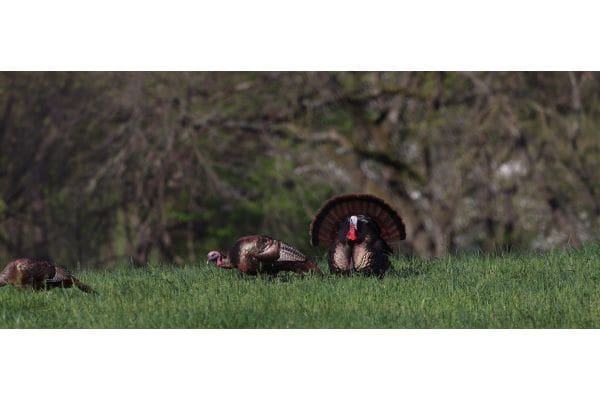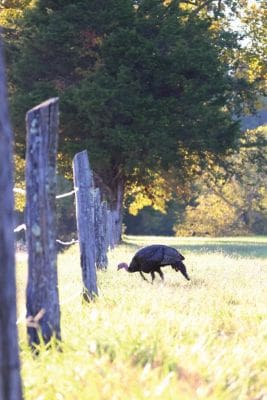City Slickers: Hunting Turkeys Near Civilization

Urban and suburban areas often hold good populations of birds. Here’s how you can take advantage next spring.
Wild turkeys are among the most adaptable animals in nature. Their unique ability to thrive in various habitat types indicates their high level of resilience. That includes their frequent inhabitance of properties within and near civilization. Turkeys commonly live in and around urban and suburban areas. Sometimes, you can hunt these city birds. But how?
Understand the Basics
Certain aspects of hunting turkeys near civilization are the same as hunting rural areas. Others are different. At least other factors are more common or of enhanced concern when hunting near urban and suburban areas.
First, hunting regulations vary greatly from one area to the next. Some areas permit hunting, but others don’t. Depending on city limit zoning, as well as relevant ordinances, hunting might be restricted to bowhunting. Other areas might allow shotguns. (Even if shotguns are allowed, consider using compounds and crossbows for safety purposes.)
Additionally, property lines are usually closer together. That makes understanding exact boundaries even more important than on larger rural tracts, if for no other reason than you’re forced to hunt closer to boundaries on smaller properties.
Further, most states don’t allow hunting within specific distances from roads, structures and other establishments. Understanding those distances is crucial to the hunt. You don’t want to accidentally fire a projectile in an out-of-bounds area.
On the plus side, despite all the red tape hunters must consider, urban and suburban turkeys still offer opportunity. Connecting strips of cover and isolated pockets often hold birds. But how do you find them?
Find the Birds
Apps and maps are among a suburban turkey hunter’s best assets. Thankfully, certain apps, such as HuntStand, offer tools that help identify pockets of habitat that might hold turkeys. For example, the Contour, Mapbox Satellite, National Aerial Imagery, Satellite, 3D Map and other layers showcase suitable habitat. The Monthly Satellite layer shows most recent changes to the landscape. The Hunting Lands and Public Lands layers indicate areas that might offer public hunting access.
Don’t think turkeys only inhabit pristine-looking habitat, though. As mentioned, turkeys are quite adaptable.
“We hunt a lot of urban and suburban areas around Lexington and Louisville, Kentucky,” said Michael Pendley, outdoor writer and veteran turkey hunter. “Despite the lack of ag or big timber, there can be lots of birds in areas with large, mainly suburban-style lots with mixed wooded areas and lawns.”
After using apps and maps to pinpoint possible areas of interest, it’s time to start road scouting. When you see birds, get out and knock on doors. Use a property info app layer to determine who owns the land and where they live. You might not always get permission, but problem areas with nuisance turkeys are more likely to produce results. And if you’re up for leasing, that might get you in the door.
“It might take a while to get permission, but once you do, and have proven that you are a safe and respectful hunter, you can often pick up additional nearby properties as word gets out,” Pendley said. “In many suburban areas, you might run across small hobby-style farms of 30 to 40 acres. These can be gold if you can get permission. They often hold the largest blocks of timber in an area and serve as roosting and gathering areas for turkey flocks.”
Where allowed, glass from parking lots, driveways and other spots that won’t spook turkeys. This helps find hotspots that offer better odds of success. Listen at daybreak for potential roost sites.
“I use subtle glassing to confirm where birds are feeding and hanging out,” said Brodie Swisher, outdoor writer and Bowhunting.com editor. “I don’t want other hunters or rowdy landowners to know what I’m up to. The key is to target consistent hangouts for the local birds before identifying an ambush point and securing permission on neighboring properties.”
When you secure access to a property, don’t hesitate to post trail cameras. It’s much simpler to scout turkeys with cams in areas that have lots of funnels and pinch points.
“The birds can be patterned like deer through the use of trail cameras,” Pendley said. “Do they tend to show up late morning? Late afternoon? Or are you close to the preferred roost area so that they pass through the area early, right after flydown and again late in the day?”
Use Suburban Tactics
After turkeys hit the ground, don’t expect them to always stay put.
“Urban birds hit the ground running to feed,” Swisher said. “There are a lot of options when it comes to urban food sources, but their first stop often seems to be on their mind before their toes ever hit the ground.”
Don’t think you need a lot of ground to kill urban turkeys, though. You don’t even need the land where they roost or feed to be successful. Sometimes, travel routes offer plenty of opportunity.
“Know the ambush point that allows you to legally and ethically kill your bird between the roost and food sources,” Swisher said. “I’ve got a buddy that tags out on turkeys every year from a 3-acre parcel tucked between birds roosting on one neighbor and the food source of another neighbor. He’s got the ultimate ambush point between where birds are and where they want to be.”
Of course, a property info layer shows property lines that hunters should not cross. Other tools, such as a distance measurement option, can reveal important distances from roads and structures, which are relevant to hunting regulations.
“Most of these lots are small,” Pendley said. “They might range from 10 acres down to even an acre or two. Because of the size, running and gunning is usually out as a hunting style. Since birds might not be roosting on these properties, it’s more of a sit-and-wait style of hunting.”
If hunters can string together a few properties, however, being mobile becomes relevant again.
“I often move from one to another based on travel patterns,” Pendley said. “I can time being on the property the same time as the turkeys. With this style of hunting, I normally pop up blinds on multiple properties and move from blind to blind as the day progresses.”
Because these pockets of habitat and individual properties are small, birds aren’t always on a tract you can hunt. Fortunately, the confined nature of urban and suburban turkey hunting keeps birds relatively close. And you can deploy calling efforts to lure them into range.
If you spook a bird, the hunt is largely finished for the day. It might cross several property lines before hitting the ground again. Wave the white flag, and try again another day.
Above all else, when turkey hunting near civilization, don’t overthink it.
“I don’t really go at it any differently from big woods to small woods,” said Anthony Virga, a Realtree pro-staffer and competition turkey caller. “I just hunt them. That might seem gray, but I honestly just go into every hunt like all others. Be patient. Patience kills. Especially in an area with more hunters and older gobblers.”
Turkeys are turkeys, after all. Even cityslicker birds.

